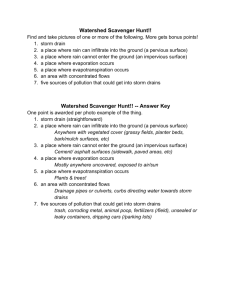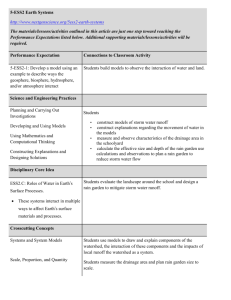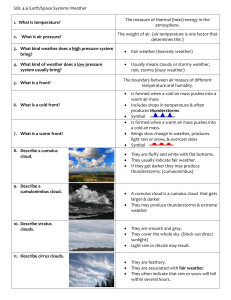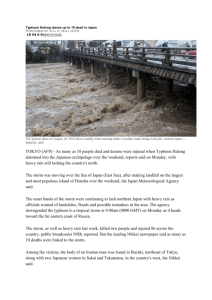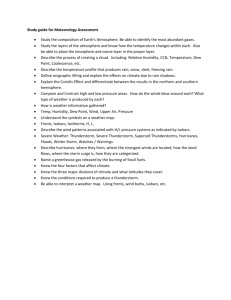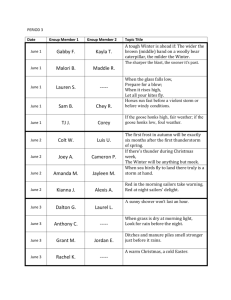NATIONAL STORM SUMMARY
advertisement
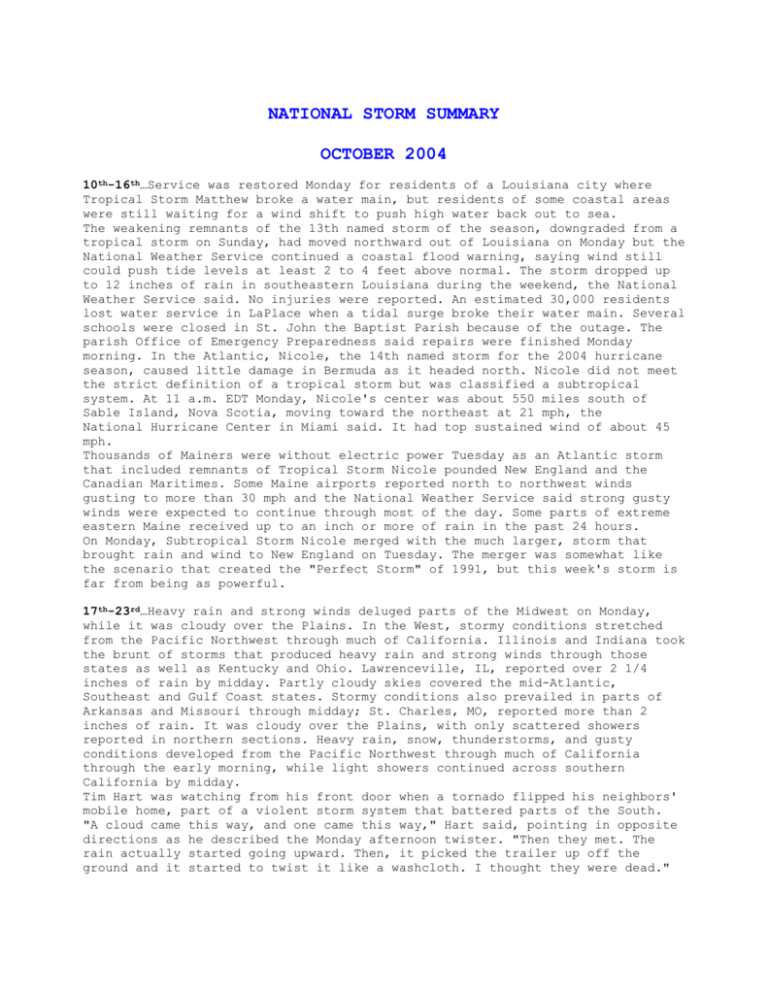
NATIONAL STORM SUMMARY OCTOBER 2004 10th-16th…Service was restored Monday for residents of a Louisiana city where Tropical Storm Matthew broke a water main, but residents of some coastal areas were still waiting for a wind shift to push high water back out to sea. The weakening remnants of the 13th named storm of the season, downgraded from a tropical storm on Sunday, had moved northward out of Louisiana on Monday but the National Weather Service continued a coastal flood warning, saying wind still could push tide levels at least 2 to 4 feet above normal. The storm dropped up to 12 inches of rain in southeastern Louisiana during the weekend, the National Weather Service said. No injuries were reported. An estimated 30,000 residents lost water service in LaPlace when a tidal surge broke their water main. Several schools were closed in St. John the Baptist Parish because of the outage. The parish Office of Emergency Preparedness said repairs were finished Monday morning. In the Atlantic, Nicole, the 14th named storm for the 2004 hurricane season, caused little damage in Bermuda as it headed north. Nicole did not meet the strict definition of a tropical storm but was classified a subtropical system. At 11 a.m. EDT Monday, Nicole's center was about 550 miles south of Sable Island, Nova Scotia, moving toward the northeast at 21 mph, the National Hurricane Center in Miami said. It had top sustained wind of about 45 mph. Thousands of Mainers were without electric power Tuesday as an Atlantic storm that included remnants of Tropical Storm Nicole pounded New England and the Canadian Maritimes. Some Maine airports reported north to northwest winds gusting to more than 30 mph and the National Weather Service said strong gusty winds were expected to continue through most of the day. Some parts of extreme eastern Maine received up to an inch or more of rain in the past 24 hours. On Monday, Subtropical Storm Nicole merged with the much larger, storm that brought rain and wind to New England on Tuesday. The merger was somewhat like the scenario that created the "Perfect Storm" of 1991, but this week's storm is far from being as powerful. 17th-23rd…Heavy rain and strong winds deluged parts of the Midwest on Monday, while it was cloudy over the Plains. In the West, stormy conditions stretched from the Pacific Northwest through much of California. Illinois and Indiana took the brunt of storms that produced heavy rain and strong winds through those states as well as Kentucky and Ohio. Lawrenceville, IL, reported over 2 1/4 inches of rain by midday. Partly cloudy skies covered the mid-Atlantic, Southeast and Gulf Coast states. Stormy conditions also prevailed in parts of Arkansas and Missouri through midday; St. Charles, MO, reported more than 2 inches of rain. It was cloudy over the Plains, with only scattered showers reported in northern sections. Heavy rain, snow, thunderstorms, and gusty conditions developed from the Pacific Northwest through much of California through the early morning, while light showers continued across southern California by midday. Tim Hart was watching from his front door when a tornado flipped his neighbors' mobile home, part of a violent storm system that battered parts of the South. "A cloud came this way, and one came this way," Hart said, pointing in opposite directions as he described the Monday afternoon twister. "Then they met. The rain actually started going upward. Then, it picked the trailer up off the ground and it started to twist it like a washcloth. I thought they were dead." Two tornadoes in Arkansas injured at least 11 people and damaged dozens of homes and other buildings, and electrical service was knocked for more than 7,000 customers. One home was destroyed and three others were damaged near Loretto, TN. Heavy rains in northern California knocked out power to at least 144,000 customers on Tuesday and forced the evacuation of 200 residents, many in areas where wildfires burned as recently as a week ago. The unusually early winter storm was concentrated over Napa and Sonoma counties north of San Francisco, where winds gusted to nearly 60 mph and some hilly and mountainous regions received more than a .50 of rain per hour. About 200 residents in hamlets along the South Fork of the American River were told to clear out Sunday because authorities feared mudslides could occur on hillsides cleared of vegetation by fires. Officials said the storm was headed toward southern California, where up to 6 inches of rain were expected in some areas. Emergency crews were bracing for potential flooding and mud and rock slides, particularly in areas ravaged by last October's disastrous wildfires. California's first major storm of the season poured heavy rain across California on Wednesday, setting off mudslides up to 4 feet deep, and dumped snow at higher elevations that slowed travelers in the Sierra Nevada. The unusually early winter storm expanded into the Sierra and Southern California on Wednesday after pouring record rainfall onto the northern part of the state Tuesday, knocking out power temporarily for at least 300,000 customers. Rescuers were searching for at least eight hikers caught in the storm in the Sierra Nevada. One man was missing in Los Angeles County after falling into a wash. The northern city of Redding got 3.12 inches of rain Tuesday, breaking a 104 year old record for the date. Records were also set in Sacramento, Stockton, Modesto and Red Bluff. Wind gusted to nearly 60 mph Tuesday. Flooding and mud up to 4 feet deep blocked the entrance to a mobile home park in Santa Clarita, in northern Los Angeles County, isolating about 100 homes. Several roofs collapsed in the region but no injuries were reported. The drenching rain prompted forest officials to ease fire restrictions. Three Southern California national forests said they would reopen hundreds of thousands of acres Wednesday that had been closed to visitors due to extreme fire danger. 24th-31st…Heavy rain dampened parts of Minnesota and a warm front brought showers and thunderstorms to parts of the Northeast on Saturday as a lingering front generated heavy rain, lightning and strong wind in parts of Texas. A low pressure center developed over Wisconsin and created widespread showers and thunderstorms in the upper Mississippi Valley, the Midwest and the northern Plains. The heaviest rainfall was in Ely, MN, which saw 1.70 inches. A warm front spread showers and thunderstorms from the Mid-Atlantic to New England, with Harrisburg, PA, reporting more than .75 of an inch of rain. A cold front produced light rain from the Great Lakes to the Tennessee Valley. A lingering stationary front brought strong thunderstorms with frequent lighting, gusty wind and brief heavy downpours to central Texas.
